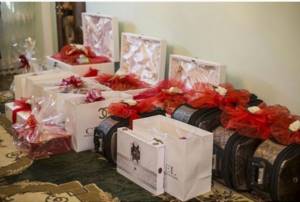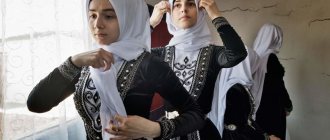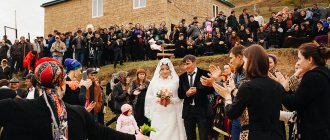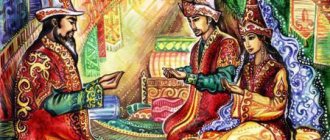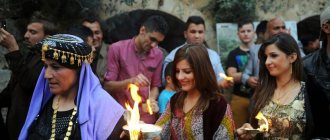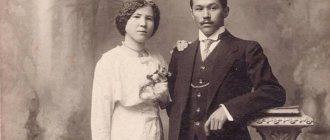Family life
The modern life of Kabardians is increasingly changing and urbanizing, but it still retains many traditional features. To a large extent, this is facilitated by the observance of Adyghe Khabze - a moral and ethical code that has been established for centuries, regulating the rules and norms of behavior. It also regulates family relationships.
Family plays a vital role. Politeness and indispensable respect for all family members prevail in relationships. The older generation is given special honor. In the presence of an elder, revered on par with a god, the younger members of the family do not speak first and will never allow themselves to be interrupted. At the table, the elder is given the most honorable place, since age is placed above rank and social status.
Family hierarchy is important, but so are marital ties. According to Kabardian tradition, marriage is possible only once. This is how family values are preserved. Otherwise, they are lost forever. Popular wisdom says: “The husband creates the wife, and the wife creates the husband.” Despite the fact that a woman is in a dependent position with a man, she enjoys honor and respect.
The Kabardian family, the morals and foundations that reign in it, are the main source for the younger generation from which they receive life lessons. Starting from childhood, upbringing in families continues throughout life. Standards of behavior are passed on from generation to generation, and everything is based on the personal example of parents.
Matchmaking
The traditional event lasts more than one day and begins with the search for the bride by the groom's relatives. As soon as a suitable candidate is found, the groom himself and his close relatives go to the bride’s house. They ask the bride's father for his blessing for the wedding. It should be noted that the groom does not always receive consent to marriage immediately. If the answer is negative, he comes to the bride’s parents a second or third time. Sometimes it takes several months to obtain consent.
On the topic of the article: features of Orthodox and Muslim ceremonies
As soon as the goal was achieved, the families of the future spouses began to negotiate about the bride price. This leisurely conversation lasted as long as it took to make a mutual decision. After the decision was made, the next stage of the Kabardian wedding began.
Hospitality
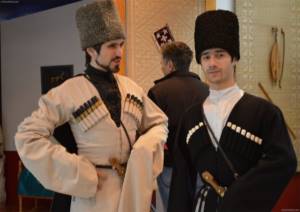
A mandatory attribute of any Kabardian home is traditional hospitality, providing every person who crosses the threshold with absolute protection. Even a blood enemy could count on appropriate honors. Receiving a guest at any time, feeding him and settling him in the house is the sacred duty of a Kabardian. Serious fines were imposed for violating the traditions of hospitality or insulting a guest.
In a Kabardian’s house, the guest is completely safe. The best dishes are placed on the table for him, and the best room is allocated - the kunatskaya. The guest usually eats alone; the host can join him only after convincing persuasion. If they are equal in position and age, then they begin the meal together.
According to custom, neither the mistress of the house nor the children sit at the same table with the guest and men. But at the same time, they are nearby, because their help can always be needed. If in cities this tradition has almost been forgotten, in rural areas it is invariably observed.
Muslims' first wedding night: how to prepare?
In order for the wedding night to pass in a tender and reverent atmosphere, it is worth preparing for it in advance. What should be done?
- Beautifully decorate the newlyweds' room, including making exquisite bed linen (in the old days, the bride sewed and decorated the bedding with her own hands). In addition, it is worth taking care of dim lighting, which will be conducive to intimate relationships.
- Buy seductive underwear for the wedding night, because the husband will see his wife for the first time without clothes on this very night, so she should look desirable and beautiful to him.
- Think about treats and drinks, because during a heart-to-heart conversation, the newlyweds may want to drink or eat. In addition, it is customary for the husband to treat his wife to sweets on the wedding night, then their relationship will be “sweet” and tender.
- Before the newlyweds arrive, you should make sure that there is no Koran in the room. This sacred book should be taken out of the room or covered with a cloth. It is also worth remembering that even animals should not be in the room that night.
Wedding
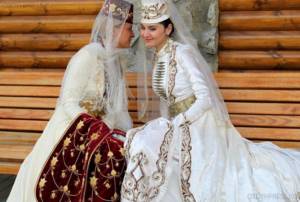
The customs of Kabardians include many interesting rituals. One of the most exciting events is the wedding. Kabardians are in no hurry to decide to get married, approaching this matter very seriously. Often, several months or even years pass between the choice of a future spouse and the wedding day. The wedding ceremony is preceded by the following rituals:
- Matchmaking. The search for a suitable candidate by the groom's relatives takes more than one day. When a worthy bride is found, matchmakers are sent to her house. Sometimes they go several times until consent for marriage is received.
- Agreeing on the amount of dowry. The families of the bride and groom discuss the bride price. Often this conversation is accompanied by disputes, bargaining and lasts until the parties reach a mutual agreement.
- Bride. The meeting of future spouses takes place in the bride's house. On the appointed day, the groom comes to visit, and the betrothal ceremony is held there in accordance with Muslim traditions.
- Payment of part of the dowry. When most of the bride price has been collected, it is given to her relatives. After this, the wedding date is set.
- Taking the bride out of the house. After paying the share of the bride price, the groom has the right to take his bride out. A whole wedding train consisting of the groom's friends usually comes for her. The beautifully dressed bride was released by her relatives under a comic ransom.
- "Hide" in other people's houses. According to the tradition of Kabardians, young people are resettled in other people's (different) houses. From this moment on, communication between the bride and groom stops.
- Moving to the groom's house. The bride is brought to the groom's home secretly. First of all, she inspects the room where she will live, and does not leave it for a whole week. At this time she does not communicate with anyone.
- Rite of reconciliation. The groom's parents reconcile with their daughter-in-law when she emerges from her temporary "imprisonment." After this, a wedding celebration is held, lasting several days.
There are several customs that are strictly observed. The groom is seated at a table with other men, after which they turn off the lights and try to pull off his headdress. The groom should not allow this. For the bride, they spread the skin of a ram on the floor, place the bride on it, and then suddenly try to pull the skin out from under the girl’s feet. The newlywed's task is to maintain balance. After all the tests comes the turn of dancing and showering the newlyweds with millet and coins.
Gradually, customs are lost, and now the most beautiful Kabardian wedding does not include a full set of rituals. The modern interpretation of traditions often comes down to only common elements - traditional outfits, music, singing, parting words. The location of the celebration has changed. If previously it was a home, now the celebration is often celebrated in a cafe/restaurant. A girl has the right to simply return to her parents if she does not want marriage.
How does matchmaking and engagement work?
Kabardians are a rather leisurely people, especially in such an important matter as choosing a bride. It is believed that a young man cannot adequately assess how good a woman will be for him as a wife. Therefore, relatives take a closer look at available girls, drawing conclusions about how well they are brought up.
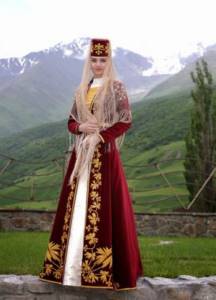
This is a rather slow method, but it allows you to collect all the information about a potential relative. Thanks to this, even a small stain on the girl’s reputation will be noticed, which will worsen her chances of a good marriage. When a guy expresses a desire to marry a girl, and if the elders of the family have no objections, then matchmakers are sent to the bride’s parents.
Among the delegation there must be an eldest man in the family who talks about his desire to become related. Parents can immediately refuse the groom, or take time to think about the proposal. Sometimes the reflection period reaches 4–5 months. After this, a second meeting takes place, where the decision is announced.
Sometimes the bride’s parents may immediately refuse the groom, but if the man is serious, then he tries to correct as quickly as possible what the girl’s family did not like. After this, matchmakers are sent again, but 3-4 months should pass between visits. When permission is received, the matchmakers and parents thoughtfully discuss the size of the bride price. This may take 1–3 months, depending on the frequency of meetings. It is considered incorrect and too suspicious if an agreement is reached very quickly.
When the conditions are satisfied by both parties, the engagement is considered concluded, after which preparations for the wedding begin.
Birth of a child
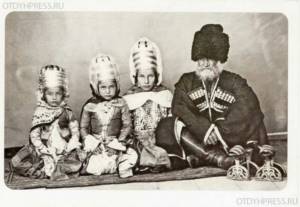
The customs of the Kabardians regarding the birth of children are very interesting. When a son was born, a red or white flag was hung on the house, and when a daughter was born, a motley flag was hung. A fruit tree was always planted in honor of the baby. This was done by my paternal grandfather.
If a boy was born, this is a joyful event. For the competitive game, smoked cheese and an oiled leather rope were tied to two high posts. Along it, competing men got to the cheese, bit off a piece and received a small prize for it.
Soon after the birth of the baby, “tying into the cradle” was arranged. The baby's cradle was made of hawthorn. According to Kabardian belief, this is a good tree. First, the cat was placed in the cradle so that the child would sleep just as well and peacefully in the future. Two weeks after birth, the baby was also laid down. The ceremony was performed by the paternal grandmother. Sometimes this procedure was entrusted to a familiar woman with many children.
For the baby’s first steps, a special holiday was also held - Lateeuve. The child's legs were tied with a ribbon, then the eldest woman in the family cut it with scissors. This symbolized that in the future nothing would stop the child from moving forward.
Thus, the birth of a child was celebrated as a national holiday - solemnly and magnificently. Both women and men were involved in raising a new member of the community.
How do modern European traditions influence the celebration of a Kabardian wedding?
Modern European trends penetrate the traditions of all peoples living outside Europe. Every year, national rituals are forgotten and identity is lost. Nowadays, not a single wedding is complete without an expensive car; everyone present tries to dress in the latest fashion. And, of course, the solemn event must be filmed on video and recorded on a digital storage medium. Special Kabardian toasts are also prepared for the wedding.
The opinions of the indigenous people are divided into opposites: some approve of the innovations, others remain adherents of the traditions of their ancestors.
Ultimately, the right to choose how to celebrate the wedding is given to the relatives of the newlyweds. In any case, Kabardian weddings are fun and spectacular.
Atalychestvo
The tradition of atalism is of great interest - a child from an early age was given to be raised in a foster family. With the birth of children in the family, candidates for the role of atalyk lined up. And the richer the family turned out to be, the longer the line was. After some time, the pupil returned to the parental home.
According to Kabardian tradition, in addition to sons, daughters were also raised. In the house of their teacher, they learned everything that could be needed for successful housekeeping. Then they returned to their parents. When the time for marriage arrived, the bride price was given to the atalyk. Attachment to adoptive parents remained for life.
What does it consist of?
Content
An Ossetian wedding dress consists of many details. The most significant of them:
- corset;
- decorative bib;
- shirt;
- caftan;
- metal belt;
- apron;
- sleeves;
- veil;
- cap.
The entire suit is made in a swing cut. The caftan is worn over the shirt and tightens the bride's figure. It is almost invisible from under the dress. The caftan fits tightly to the body and prevents the chest clasps from coming undone. They are considered more decorative rather than functional elements of the costume.
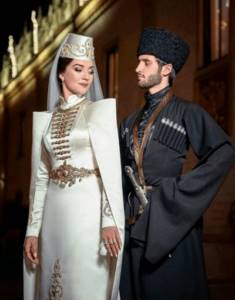
On top of the shirt under the caftan, the bride wears a corset. It is fastened with a cord or braid, on which numerous knots are tied. According to tradition, the corset must be untied without the use of sharp objects and the cord must not be broken.
The swing dress features hanging, flared, wide sleeves and a nipped waist. In some decorations, a narrow straight sleeve is allowed, which is noticeably slanted at the wrist. On a narrow sleeve it is necessary to put on wide sleeves from the very elbow.
The Ossetian bride wears a cap on her head, which is framed by a veil and decorated with gold and silver threads. There are many traditions associated with the headdress. It served to ransom the newlywed at the wedding, and if it fell into the wrong hands, it was believed that there would be trouble. The cap is made in the shape of a truncated cone and should be red.
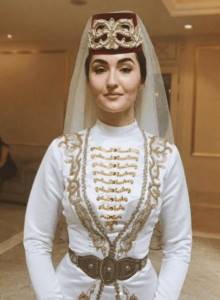
The belt protects the bride from evil glances and the machinations of ill-wishers. It can be made of fabric or silver. The richer the belt, the more abundantly it is decorated with stones, the more prosperous the girl’s family and, therefore, the wealth will accompany the young people all their lives. The fabric belt is a masterpiece of embroidery and decoration, while the metal belt looks like the work of a jeweler.
Interesting customs and signs
Kabardians believed that the well-being of their family depended on the choice of place to build a house. A suitable place was considered to be that piece of land on which any iron objects were found, with dense vegetation and water nearby. The suitability of the place was also checked by the following method: a bucket or cup of milk was left in it overnight. If the amount of milk did not change by morning, the place was considered good. This custom continues to this day.
Kabardians had many different signs associated with houses. The main place of the dwelling was considered to be the hearth, located in the largest room. It was revered as a shrine. A word spoken at the hearth became sacred. It was forbidden to cross the threshold of a house with your left foot, or to run or jump into a house. According to the custom of our ancestors, this brought misfortune. It was also forbidden to greet each other through the window.
The guest was forbidden to touch the broom, which was located in the corner, near the front door. It was considered a bad omen when a broom fell in front of a guest entering the house. Sweeping or throwing away trash at night was not allowed. Passing a knife, sewing needle or other sharp objects with the tip first is also prohibited. You cannot throw the water you were bathing in over the threshold - this was considered a bad omen.
Kabardians also have many customs associated with the burial of the dead. Believing in an afterlife, they made sure that the deceased had everything he needed in the next world. For this purpose, necessary things were depicted on gravestones and monuments. A wake was always held at the guest house. The clothes of the deceased were kept there for a year, turned inside out - this meant that the relative was always expected back.
The traditions and customs of the Kabardians attributed an indifferent attitude towards death. Therefore, on the anniversary of the funeral, they did not mourn for the deceased, but held target shooting competitions, horse races with prizes, and children's competitions.
Bridesmaids and bride price
The slowness of Kabardians is fully reflected in wedding traditions. After the matchmaking ceremony, the bride's ritual viewing takes place. And only if they are successfully completed, they begin to prepare for the engagement. It should be noted that you don’t have to wait long for the ritual of exchanging wedding rings. The bride's ransom or "coming off the pillow" is very interesting: the girl, surrounded by friends, stands on the pillow, and the groom's relatives begin to ransom her. When the groom pays the pre-agreed portion of the bride price, he can take his future wife out of her parents' house. The bride must leave and enter the house exclusively with her right foot. At the same time, without turning around or stumbling, because according to beliefs, the souls of the dead live under the threshold. Newlyweds were required to live in separate houses. According to custom, the groom was not allowed to see or talk with relatives, the bride and elders until the wedding day. Only after days spent alone with herself, with her own thoughts, was the bride brought to the house of her future husband. She settled in a room that was reserved for their life together. But the girl was not allowed to visit the common room for a couple of weeks. There is another very funny wedding custom and it is called “elopement of the old lady” - the grandmother of the newlywed. It is carried out to show their respect for elders. The newlyweds are obliged to return the grandmother back after elopement, thus showing that she will always be welcome in their home. Kabardian weddings are very spectacular. Unfortunately, with each subsequent generation, customs and traditions are forgotten. And modern weddings often feature only national costumes and dances, which causes indignation among older residents.
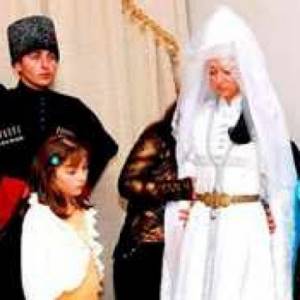
Marriage in the face of Allah and official civil registration
After the Imam enters into a marriage according to the laws of the Islamic religion, preparations begin for the official part of the celebration. After the first wedding night, it is customary for guests to show the sheet on which the newlyweds spent their night. Although this contradicts modern moral and ethical principles. The first two days of pre-wedding preparations, the groom's family continuously celebrates the upcoming event. On the third day, they are joined by the bride's relatives, who brought a dowry: jewelry, clothes, household items and money. They slaughter a ram and take out the best wine from the cellars. The parents of the newlyweds are not present at the official wedding in a state institution. After receiving the marriage certificate, everyone goes to the groom’s house, where the banquet itself is planned. Only the male relatives from both sides sit at the table. They congratulate the newly-made husband, introduce him to the elders, and will definitely try to turn off the lights and steal the groom’s headdress. The young man’s task is to prevent them from doing this and leave the room with his friends. When the bride is introduced to the groom's family, a lamb skin is brought to the center of the hall. Having placed the girl on top of her, everyone is trying to sharply pull the skin from under her feet. The bride’s task is to hold on and not fall. Then dancing, showering the bride with millet and small money.
According to etiquette at Kabardian weddings, men and women must have fun separately from each other, and the bride must be hidden from the eyes of strangers under a veil.
The art of cooking is a universal heritage. The national cuisine of Kabardians and Balkars has developed historically and has its own specific characteristics. In general, all food was divided into everyday food - everyday, holiday, travel and ritual. The daily food of most peasants was monotonous. It consisted of ayran, Kalmyk tea, sheep cheese and chureks. Festive occasions and the performance of various rituals were distinguished by large feasts, for which a variety of foods and drinks were prepared.
Kabardians and Balkars solemnly celebrated the birth of a child, especially a boy, who would continue the family line. These celebrations were organized by his grandparents or uncles and aunts. They informed all relatives about the day of the holiday. The family began to prepare the national drink - buza (makhasyma, boza), fried lakums, slaughtered chickens, rams, etc. They prepared national halva (khyelyue). There was no specific date for these holidays. It could have been held in the first days after the birth of a child, or timed to coincide with the ritual of tying a child into a cradle. Relatives brought to the holiday: a basket of delicacies, live and slaughtered chickens, and a live ram.
The most important part of this holiday was the sacrifice in honor of God. The person who was trusted to slaughter a ram or a bull said special words: so that God would make the boy strong, strong, prolong his life, etc. On the day of such a holiday, a competition was held. A post with a crossbar was dug into the yard. Round smoked cheese was hung on the crossbar. The competitors had to reach the cheese along a well-oiled leather rope and take a bite. A prize awaited the winner.
As soon as the child began to walk, a ceremony of the first step (lieteuve) was held, to which neighbors and relatives were invited. To perform this ritual, the child’s family baked special bread from millet or corn flour, which was called “leateuve mezhadzhe” - “bread of the first step.” Those invited brought lakums, chicken, etc. National halva was prepared.
Women and children took part in the ceremony. According to custom, various things were placed on top of the mezhaje: a whip, a dagger, the Koran, blacksmithing and jewelry tools. The child was allowed to choose from them what he liked. If he chose a whip, then he was predicted that he would become a dashing rider; if he chose the Koran, he would become a mullah; if he chose a tool, he would become a blacksmith or jeweler. Such testing of the child’s future inclinations and interests was also carried out for girls.
The Balkars, for example, celebrated the appearance of a child’s first tooth with a special treat to which women and children were invited. For this, various dishes were prepared, but always “zhyrna”. It consisted of well-boiled grains of corn, barley, beans, and wheat, pounded in a special mortar.
Food occupied a large place in wedding rituals. Usually a family whose son got married prepared a large amount of the national drink - buza. They were sure to treat everyone who came to congratulate them. For the wedding day, the family and other relatives prepared various national dishes and drinks. Halva, buza, and slaughtered ram were considered mandatory for wedding celebrations. Usually, before leaving for the bride, all residents of the village were invited to a gathering evening feast. Usually the procession taking the bride away was not released from the yard until the “barrage guard” received a reward in the form of a bowl of buza and various dishes. The wedding procession was accompanied by the aul youth, the bride's relatives, who took with them a jug of buza, lakum, meat, cheese, etc., and a farewell feast was held on the border of the village. On the way, the wedding procession was met by the groom's relatives with drinks and food and organized refreshments in the field, toasts were made, dancing was held and everyone went home together. After the Lezginka was performed in the courtyard, all participants in the wedding procession were taken to their rooms and treated until the morning. The dashing riders who managed to enter the bride’s room on horseback were presented with a large bowl of buza, a plate of pasta, meat, and delicacies.
An obligatory part of the wedding is smearing the bride's lips with honey and butter. This ritual was performed two or three days after the bride was brought on the day of her entry into the large room where the mother-in-law lives. Usually this procedure is performed by the most authoritative woman of the family, and this symbolizes the desire of the family for their young daughter-in-law to be sweet and pleasant, like honey and butter, and for the new family to seem just as sweet and pleasant to her.
According to custom, the groom stayed with one of his comrades on the wedding days. He was visited by friends, relatives, and fellow villagers, who were always given food and drink.
The groom's family was preparing for his return home. They gathered the oldest members of the clan and neighbors. The groom and his companions were waiting at the door of the room where the old people were sitting. The eldest of them, turning to the groom, said: they welcome the arrival of a new person into their family, forgive him for his actions, hope for courtesy, diligence, diligent work, etc. As a sign of “reconciliation,” he was presented with a large bowl of buza with a plate of various dishes, which the groom passed on to his comrades.
Among the Balkars, the groom hid for 7 days, and if circumstances did not allow him to hide for more than 7 days, then a ransom day was appointed. The herald announced throughout the village about the groom’s desire to pay off and invited everyone to the gathering place. Beer and several whole roasted lambs were brought here from the groom, and the feast began. The newlywed was also present at this feast. This ritual ended the entire wedding process. This ritual of the Balkars differed from the Kabardian one. If among the Kabardians the “conciliatory” feast was organized by the groom’s parents, then among the Balkars it was the groom himself. In order to “reconcile” the groom with his mother, the Kabardians held a women’s holiday, where the mother presented her son with a bowl of buza and sat him on a bench. This ritual symbolized the final “reconciliation” of the son with his family.
According to custom, Kabardians and Balkars, when visiting a sick person, brought food. This is still considered mandatory if you come to visit. The usual ingredients for this are boiled chicken, a few rolls, fruits, vegetables, etc. This is also done if the patient is in the hospital. If a man comes to visit, he doesn’t bring anything with him.
Kabardians and Balkars paid great attention to treating familiar and unfamiliar guests. The traveler could count on the most cordial welcome in the home of every mountaineer. Any person was obliged to provide the guest with a hearty table and a good fire. The guest was treated to delicious and varied food. They prepared for the guest: gedlibzhe, litsiklibzhe, delicacies, pies, etc. They were treated to buza, and in Balkaria - beer. But not everyone was treated equally. For example, female guests were treated without the national drink, but sweet tea was always served, which was not given when treating men. National halva was not prepared for random guests, but it was mandatory when receiving guests whose arrival was known in advance. For fellow village guests, if they were not specially invited to the celebration, there was no obligatory guest meal; they were limited to chicken or fried meat.
Kabardians and Balkars are still famous for their hospitality and hospitality. They still observe all the positive traditions and customs associated with the ancient institution of hospitality.
There were also forbidden foods. For example, the girls were not fed chicken stomach; they were told that their lips would be blue. Children were not given kidneys because they “slowed down” growth. Children were also not allowed to eat their tongue, as there was a belief that if a child eats his tongue, he will become talkative.
A lamb was slaughtered for the guests. The most honorable part was the head, half of which was given to the man. Women were not allowed to eat the head.
Numerous traditions and customs developed over centuries were associated with food, its preparation, and serving.
Kabardians and Balkars taught their children the ability to cook food. From an early age, girls were taught to help their mother clean the room, wash and organize kitchen utensils, help in preparing food, and cook it themselves. The mandatory code for raising girls included knowledge of all national dishes, methods of preparing them, and the order in which they were served. A girl was judged not only by her appearance, but also by her upbringing, ability to do needlework, and cook delicious food. Boys were also taught how to cook food.
Kabardians and Balkars have always been distinguished by moderation in food. It was considered completely unacceptable and indecent to say that you were hungry. Greed for food was considered a serious human vice. The custom demanded that he leave some of the food, although he himself was not full. Custom also did not allow one to be picky about food, to choose or ask for one dish and refuse another.
The food was prepared by the eldest woman of the family or one of the daughters-in-law. She divided it among family members.
Usually food was prepared with a certain reserve, because guests could arrive unexpectedly. Moreover, even a well-fed person did not have the right, without violating custom, to refuse food. Being hospitable, Kabardians and Balkars did not take kindly to a guest’s refusal to eat. This could offend them. On the other hand, they looked at the person who ate their bread and salt as their own, dear, close person and provided him with all kinds of help.
In the past, the food of Kabardians and Balkars was characterized by seasonality. In the summer they ate mainly dairy and vegetable foods, and in the fall and winter – meat.
It is now becoming increasingly difficult to judge the traditional appearance of Kabardian settlements. The old villages have long been rebuilt and fewer and fewer old houses are preserved. At the same time, the old signs and beliefs of Kabardians associated with housing are also disappearing.
In the distant past, Kabardians believed that their happiness and well-being largely depended on a well-chosen place for their house. Therefore, the choice of location was taken with great seriousness.
A good and healthy place to build a house was considered to be one where some iron objects were found, where there was a lot of vegetation, and where there was water nearby.
At the place where they were going to build a house, they dug a hole and filled it again with the same earth.
If the dug earth did not fit when backfilling, then the family in this house was predicted to have abundance and prosperity in the future. There was also a custom: they put a bucket or cup of milk in the chosen place in the evening and left it overnight. And if the milk did not decrease by morning, the place was considered good for building housing. 1
At the site chosen for construction, old iron objects were buried, because... They believed it brought happiness. In our time, this custom is still observed.
They buried coins under the houses and said wishes. There were often cases when Kabardians, with prayers and later with amulets (dyshche) of Muslim mullahs, tried to protect the estate and the area under the future house from everything bad and unfortunate and to ensure the well-being of the family.
Building a house
When fencing a manor and building a house, Kabardians widely used the ancient folk custom of mutual assistance (shch1yhyehu). The population resorted to this custom of mutual assistance both when procuring building materials and when building a house,
“No one built a house without the help of relatives, neighbors and fellow villagers. I remember it very well. Because I had to take part in them more than once. During my school years, all summer long on Saturdays and Sundays we were invited to help those who were building. And they built everything" * .
When building a house, Kabardians could not do without the help of relatives and neighbors. According to tradition, the first pillar was placed in a hole and buried by the elder of the family. The beginning of the construction of the house was celebrated with a small holiday. At this holiday, everyone wished happiness to the future home, health and prosperity to the owners. To the one who built the house they wish: “Ui 1ykh’e k1ykh’ ukh’u” (May Allah make the house happy), “Alyhym fysh1ig’etynshikh, fysh’1ig’ebeg’ukh” (May Allah grant that you live well, calmly, and get rich in it). The one who first enters the house wishes: “Them laape mahue kyyschIetkhaue g kyysch1igek1” (Allah grant, good day brought by us). The villages had no layout, the houses were located in disarray. The streets were narrow and crooked.
In the villages of Kabarda there were quarters that had different sizes and shapes. One block was separated from another by back alleys. Until the second half of the 19th century, Kabardians gathered and discussed issues of the entire village and society at the mosque. There were from one to five mosques in the villages. Among Kabardians, when a family was divided into two or three parts, the estate was not split up. It was given to one of the sons, who was chosen at the discretion of the head. Those who were left without property moved to the outskirts of the village.
* (informant Shadov B.M.)
The estate was surrounded by a wattle fence, and in some villages even a stone fence, the height of which reached two meters.
Since the end of the 19th century, estates began to be surrounded by trees (acacia, plum, cherry). All estates had fences, but the courtyards were connected by alleys. The length of the fence did not exceed 5 meters, height 1.5 meters.
Even earlier, Kabardians had single-chamber dwellings, oblong in shape with semi-oval ends. Single-chamber houses had only one door, made of two leaves and oak boards. Its height did not exceed 150 - 160 cm. At the same time, a second door appeared for women to enter the garden. On the front side of the house, along its entire length, they began to build a small canopy, which, with the advent of the foundation, turned into an open gallery. * Windows appeared in the mid-19th century, but glass was available only to the wealthy segments of the population. In the 90s, most settlements did not have windows. Light entered their homes through a smoker, and the doors were wide open both in summer and in winter. Therefore, these houses were cold and dark in winter. With the development of productive forces, people's lives also changed. They began to replace single-chamber houses with two-chamber ones. At the end of the 19th century, it became the most common type of housing for Kabardians. Single-chamber houses differ from two-chamber houses in the layout and location of entrances. The room attached to single- or double-chamber houses had a separate entrance and was called legyuna (room for newlyweds). If sons married in the family, then rooms were added to the house. This is how the long house was formed. There were also houses that had from 8 to 14 rooms. In the second half of the 19th century, three-chamber houses appeared, which had large rooms, rooms for newlyweds had two
* Mambetov G.Kh. “Traditional culture of Kabardians and Balkars” -
entrance. Food, kitchen utensils and water were stored in the hallway. Sometimes food was prepared there. At the end of the 19th century, houses began to be built with one door. When multi-chamber houses appeared, large families fell apart. In long or three-chamber houses, a certain room should belong to the parents. In most cases, two- or three-chamber houses had glazed windows,
Signs and beliefs of Kabardians associated with housing
Cult of the Hearth
Kabardians observed many customs associated with the home. In the dwellings, the most revered place was the hearth (zhiegu), which was located in a large room (uneshkhue). This room with a fireplace was both a kitchen and a dining room; the oldest members of the family lived in it.
The hearth and hearth chain were considered family shrines. A word given near the hearth was considered sacred and must be fulfilled.
In the past, the bride always walked around the hearth, expressing her readiness to become a member of the family. According to ancient beliefs, the hearth chain had magical powers and could protect both home and family. The Circassians had a custom according to which, when there was a threat of epidemic, the hearth chain was drawn around the village. The hearth chain could not be thrown away or sold. It was forbidden to swear near the fireplace; it was forbidden to pour dirty water into the fire. The mistress of the house had to light the fire in the hearth. Every evening, the owners of the house placed food for the brownie near the hearth and asked him to protect the house from evil spirits.
Attitude towards elders
The son did not sit down in the presence of his father, and the younger brother did the same in front of the elder; young people in the presence of elders did not speak loudly, did not swear, did not use foul language, much less fight, they also did not laugh loudly. At the same time, it was unacceptable to keep your hands in your pockets, stand half-bent, sit lounging, fidget in a chair, turn your back to others, scratch your head, pick your nose, chew, be dressed casually, rest your cheek or forehead with your hand, or smoke.
According to the custom of the Kabardians, age was placed above rank and position. A young man of the highest birth was obliged to stand before every elder, standing respectfully to greet him, without asking his name, to give way to him, not to sit down without his permission, to remain silent in front of him. Briefly and respectfully answer his questions.
According to the customs of the Kabardians, they were supposed to get up when the elders drank water, sneezed, when their name was pronounced in their absence, especially if they were no longer alive.
In any house, the eldest had his own special place where he sat, his own bed. This venerable place was located against the wall, opposite the entrance to the room. No one sat in the elder’s place; even someone else’s hat was not supposed to be placed on his bed. Only the thamada himself could seat the respected and close guest who had arrived in his place.
The younger generation of Kabardians was brought up so that they did not strive to take a place of honor in the room, they remembered that an older one might come and need to give up this place. That’s why people used to say: “Adygal1 zhant1ak1uekyym” (Adyghe man does not climb into a place of honor). This is due to the fact that Kabardians had a strictly observed seating order at the table. Everyone had to occupy a place corresponding to his age and rank. Violation of this principle could cause displeasure among those present, even resentment. Therefore, each convinced the other that this place should be taken not by him, but by the other. This custom was so strictly observed that with the arrival of new invitees it was necessary to change seats several times, giving way to an older and more worthy one. It is no coincidence that they say that “Adygem-t1ysyn dymyukhyure kguezhyguer koos” (We, Adygs, did not have time to sit down, the time has come to disperse). Nevertheless, this desire to give up his place to someone older and more worthy was evidence of good manners, politeness and modesty. On the other hand, these examples emphasized that if you are invited to visit, you should not be late. *
Kabardians believed in many signs associated with home.
According to folk custom, you cannot cross the threshold with your left foot.
From childhood, children were taught not to run or jump into the house. It was believed
that it brings misfortune.
According to folk custom, you cannot say hello through a threshold or window.
It is still not allowed to call out to a person who has left the house, as
he might get into trouble.
A stranger or a guest was not allowed to touch the broom. The broom should always be in the corner, not far from the door. If a broom fell in front of a guest entering the room, it was considered a bad omen.
An interesting custom was according to which the umbilical cord, when cut off, was coated with bull dung for a boy, and with heifer dung for a girl, and buried in the corner of the room.
The hair that was shaved for the first time from the newborn’s head was not thrown away; it was also buried in the corner of the room. In any home, even now, the first tooth that falls out is thrown onto the roof of the house or attic, with a piece of salt and coal from the fireplace. It is believed that this ensures longevity for the child and abundance for the home.
Do not pass the knife and needle with the sharp end. Sweeping and throwing away trash at night is also not allowed. If the knife falls with the tip up, this leads to the forced slaughter of livestock. You cannot pour the water you have bathed in over the threshold. * R.A.Mamkhegova “Essays on Adyghe etiquette” -. .
The work was done by Shomakhov Anzor Beslanovich. I made some adjustments and photos.
On my own behalf, I would like to add that we, like the whole world, are moving towards globalization. No one wears Circassian women anymore and observes all these signs; they are not an integral part of everyday life and culture. They remained in memory as part of folklore, and even then mainly among the elders; young people mostly consider it a relic of the past.
A Kabardian wedding is a beautiful and joyful event. This important day in the life of newlyweds is often accompanied by conflicts. And they arise because the traditions of a Kabardian wedding involve a very long matchmaking process. It can last for several years, heating up passions around the newlyweds. How do Kabardians get married? The following options exist: 1. By mutual decision and agreement of both parties. 2. By consent of the future spouses, after which their friends inform their parents. 3. Kidnapping of the bride with or without the consent of the girl and her relatives. Sometimes fake kidnappings are carried out.
Wedding gifts
At Caucasian weddings it is customary to give a lot of gifts. The following are invited to such events:
- relatives;
- neighbors;
- friends;
- strangers.
They should all come with expensive gifts. Only the bride's relatives should not attend the wedding at the groom's house.
